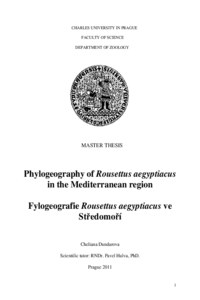Phylogeography of Rousettus aegyptiacus in the Mediterranean region
Fylogeografie of Rousettus aegyptiacus ve Středomoří
diploma thesis (DEFENDED)

View/
Permanent link
http://hdl.handle.net/20.500.11956/48120Identifiers
Study Information System: 67264
Collections
- Kvalifikační práce [20083]
Author
Advisor
Referee
Janko, Karel
Faculty / Institute
Faculty of Science
Discipline
Zoology
Department
Department of Zoology
Date of defense
13. 9. 2011
Publisher
Univerzita Karlova, Přírodovědecká fakultaLanguage
English
Grade
Very good
Keywords (Czech)
Rousettus aegyptiacus, kontrolní oblast mtDNA, fylogeografie, východní MediteránKeywords (English)
Rousettus aegyptiacus, mtDNA control region, phylogeography, landscape genetics, demography, eastern MediterraneanRod Rousettus má pro kaloně netypický areál zahrnující Asii i Afriku. V Persii, Arábii a východním Středomoří tvoří severní hranici rozšíření čeledi. To bylo ovlivněno schopností echolokace, která umožnila této skupině používat jako úkryty jeskyně, šířit se nezávisle na přítomnosti lesních biotopů a osídlit oblasti s mediteránním typem klimatu. Cílem práce je pomocí sekvenování mitochondriálního markeru s rychlou evolucí studovat genetickou variabilitu, její geografickou distribuci a demografii u severních populací kaloně egyptského (Rousettus aegyptiacus). Fylogenetické rekonstrukce naznačují relativně hlubokou divergenci mezi disjunktními částmi areálu ve východní Africe a východním Mediteránu. Haplotypy ze Sinaje a Jordánu mají bazální pozici v rámci severního klastru, což ukazuje na roli příslušných oblastí při kolonizaci východního Středomoří. Severní haploskupina je středně diverzifikovaná s částečnou geografickou lokalizací jednotlivých haplotypů. Signifikantní korelace mezi maticí genetických a geografických vzdáleností svědčí o určitém omezení genového toku mezi jednotlivými koloniemi, přinejmenším u samic. Analýzy landscape genetics odhalují diskontinuity v prostorové distribuci genetické variability, v některých případech korelující s geografickými bariérami, např. na Kypru, kde patrně hraje roli...
The genus Rousettus has distributional pattern unique among fruitbats comprising both Asia and Africa and reaching northern distributional limits of the family in Persia, Arabia and Mediterranean basin. This could be ascribed to the ability of echolocation, consequent cave dwelling, and presumably other site-specific adaptations, which enabled dispersal independent of forest block and surviving in Mediterranean type of climate. Using fastly evolving mitochondrial marker, we aimed to assess genetic variability, its geographic distribution and demography of northern populations of the Egyptian fruitbat (Rousettus aegyptiacus). Mitochondrial network indicates deep genetic divergence between disjunct Mediterranean and eastern African parts of the range. Basal position of Sinaic and Jordanian haplotypes within northern clade indicate important role of these regions in colonization of eastern Mediterranean. Generally, the northern haplogroup is moderately diversified with partial geographic localization of particular haplotypes. Significant isolation by distance pattern suggests relatively pronounced site fidelity of particular colonies, at least in terms of maternal gene flow. Landscape genetics analyses indicate discontinuities in distribution of mitochondrial genetic variability, in some cases correlating with...
